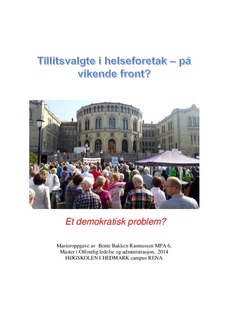Tillitsvalgte i helseforetak på vikende front? Et demokratisk problem?
Master thesis
Permanent lenke
http://hdl.handle.net/11250/274114Utgivelsesdato
2015Metadata
Vis full innførselSamlinger
Originalversjon
Rasmussen, B. B (2014). Tillitsvalgte i helseforetak på vikende front? Et demokratisk problem? Rena. Høgskolen i HedmarkSammendrag
I denne oppgaven ser jeg på partsamarbeidet i helseforetak under organisasjonsmodellen som er beregnet på forretninger: virksomhetsstyring eller Corporate Governance.
Tillitsvalgte er en del av de såkalte Arbeidslivsrelasjoner. Her er samarbeidet mellom tillitsvalgt og ledelse den viktigste relasjonen, utfra den erkjennelsen at det alltid vil foreligge en konflikt mellom arbeid og kapital, mellom arbeidsgiver og arbeidstaker. Arbeidsgiver sitter med eiendomsretten og kapitalen, arbeideren sitter med arbeidskraften. Men hvis en samarbeider kan begge få nytte av dette. Samarbeidet er basert på en erkjennelse av felles nytte.
Virksomhetsmodellen er annen type organisasjonsmodell - der er forholdet mellom styre og eiere det viktigste. Eiendomsretten eller styringsretten står sentralt, og få konsekvenser for samarbeidet med tillitsvalgte. Tillitsvalgte blir en hindring, avtaleverket blir en hindring og lovverket blir en hindring. Det er en såkalt «top-down» styringsform hvor avgjørelser blir tatt i styrerom og formidlet ned til arbeideren. Ønsket om å være «herre i eget hus» har også ført til ønsket om en sterkere ledere, mer styringsrett og mindre medvirkning fra tillitsvalgte. Arenaen er i styrerommet.
Det som også er en sterk bekymring i dette bildet, er at avgjørelser foretas mer og mer i de lukkede rom. Politikeren er ute av styrene og det er vanskelig å få innsyn i mange styringsdokumenter. Dette representerer en endring i de demokratiske kanaler for tidligere forvaltningsbedrifter.
De gamle slagordene i fagforeningene om likhet, frihet og rettferdighet får kanskje sin renessanse etter hvert som styrerommene blir mere lukket, mål og resultatstyring enda sterkere, og arbeidsgivers styringsrett blir et muliggjort i form av et svakere lov og avtaleverk Engelsk sammendrag (abstract)
This thesis is about union representatives in hospitals. The heading that is used, translated into English as: «Union representatives in hospitals – on the wane? Does it represent a democratic problem? »
Norway has a strong labor movement, and the tripartite concertation, consisting of the Government, the Trade Union and the Employers Association in Norway, has shown to bring wealth and peace to the welfare state as well to the worker. The Basic Agreement- Hovedavtalen- is the main document /act for the members. This document regulates bargaining every second year, and the dispute of interest.
The research topic is whether the working relation i.e: Industrial Relation has been left in advantage of the Corporate Governance and is focus on the shareholder instead of the stakeholder. The arena of collaboration has been restructured, which has made collective negotiations and daily cooperation more difficult to conduct.
Norway had a major hospital reform in 2002, in which management and economic philosophy were some of the main issues. This reform was heavily inflicted by the international wave of New public Management or the new liberalistic movement. The hospitals also changed their organizational form from public administration entities to become parts of health enterprises.
So- how are representatives dealing with this organizational change? Does it affect the mutual grounds for negotiations and cooperation? Or do the representatives turn to the media to tell their version of the story? Why have the representatives found it necessary to turn to media to present their point of view?
To investigate this further, I have done a survey consisting of 82 representatives. The questions are regarding issues that range from Basic Agreement, Management, economic issues, ethics and trust.
In addition, I have included an appendix consisting of historical facts about how the trade union had become trade unions in the late 1800. I have also collected several newspaper article displaying the representatives take on utilizing media for presenting their point of views. So, is there any conclusion?? Maybe it is that the “soul” of the Corporate Governance does not go along with the Norwegian Model and the tripartite concertation. Most of the Union Representatives in this survey claim that they need to use media in order to voice their power. They state that this is due to reduced opportunities for negotiation with their managers. The management reform has changed many of the channels that the representatives had to communicate with the management. These channels provided the opportunities for mutual negotiations. Corporate Governance represent a “top down” hierarchy and leave little or no room for negotiations with the trade unions representatives

